FORWARD FACING: Innovations that are Moving Building Enclosure Design, Fabrication, Installation and Performance in Bold New Directions
The self-cleaning and heat-reflecting properties of exterior finishes can be an important means to help buildings look and perform better over time. They can also help owners effectively manage their buildings better since ongoing maintenance costs can be much less compared to traditional finishes. Environmentally, at least one manufacturer uses a photocatalytic technology that helps break down atmospheric pollutants in the air and on the surface. These same photocatalytic properties are what help keep the wall surface temperatures cool as it reflects heat from the sun. Ideal applications for this type of finish include new construction or refinish projects over EIFS, stucco, masonry, or concrete substrates.
Silicone-Based Air Barriers
An important part of any exterior wall assembly, which is also mandated by building codes, is an air and water resistive barrier. There are numerous products on the market available to address this but one of the most effective, especially for larger buildings, is to use a spray- or roller-applied silicone coating over an appropriate substrate. One of the better known types is a one-part, liquid-applied elastomeric coating that cures to form a flexible, vapor-permeable membrane. This water-based silicone air barrier may be readily complemented by a fully compatible high-performance array of compatible products for addressing edges, seams, openings, and other common construction conditions.
A key characteristic of silicone air barriers is their ability to prevent air and water infiltration but retain the ability to “breathe” by allowing trapped moisture or water vapor to escape. This attribute mitigates concerns about potential corrosion and mold growth caused by moisture trapped inside wall assemblies. Of course, during construction, this same material needs to be able to handle exposure to the elements, particularly sunlight and potentially harmful ultraviolet (UV) radiation and products are available to meet that need. Similarly, the material needs to tolerate temperature differences during construction allowing applications in a range of conditions. At least one such product has been tested and found to be capable of successful installation in temperatures as low as 20°F (-6°C).
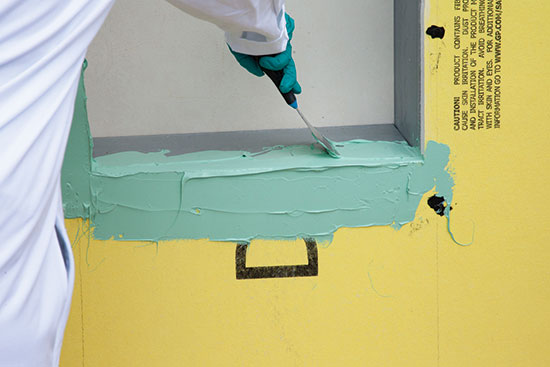
Photos courtesy of Dow Corning
Spray- or roller-applied water-based silicone air barriers, which can be complemented with compatible silicone flashing and related materials, can provide a complete, high-performance air and water-resistive barrier that allows trapped moisture to escape.
In addition to the spray-on air barrier, the other products of a complete system typically include sealants and flashings to properly cover and seal the locations other than the flat surface of a substrate. This includes compatible and primer-less liquid silicone flashing at window and door openings, silicone sealant along joints or seams, and silicone transition strips for plane changes or corners. Together, this proven, coordinated system of compatible products provides long-term durability for the building enclosure while helping to improve the thermal and weathering performance of facades.
Fenestration Systems
Virtually all building facades incorporate some form of fenestration, and most architects spend a good deal of time sizing, arranging, researching, and specifying it–all for good reason, since there are many ongoing advances and trends in window fenestration systems. Improved energy efficiency in particular continues to be one of the strongest trends and one most likely to endure as driven by client needs and building codes. Manufacturers have responded by developing new fenestration products and installation methods. Architects are specifying improved thermal barriers in aluminum window, storefront and curtain wall systems, selecting more energy-efficient glass with many varieties of low-E coatings or triple glazing, incorporating many different types of glass on the same building, adding exterior sunshades and interior light shelves, and trying out self-shading electrochromic glass. One specific response to this energy performance trend is the availability of wood and aluminum-clad wood windows with triple glazing and optional krypton gas that achieve exceptional thermal performance with U-Factors as low as 0.16.

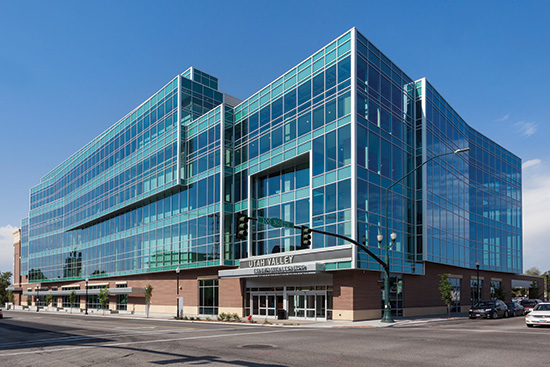
Photos courtesy of Pella EFCO Commercial Solutions
Fenestration trends, whether for new construction or existing buildings, include pre-engineered, factory-glazed systems that can provide design options while still meeting cost and scheduling needs.
Notice

www.acpexpress.com

www.buildabetterbarrier.com

www.fibertite.com
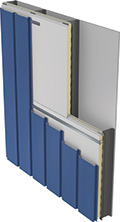
www.metlspan.com

www.parex.com
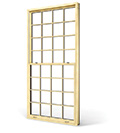
www.pellacommercial.com
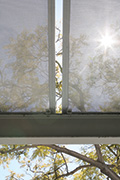
www.sergeferrari.com

www.tubeliteinc.com









